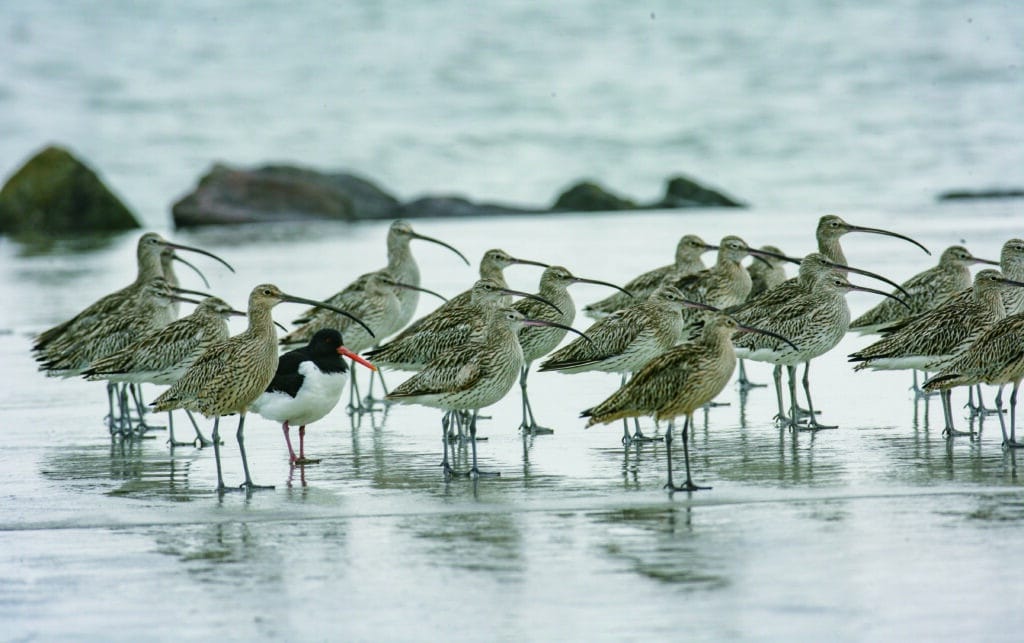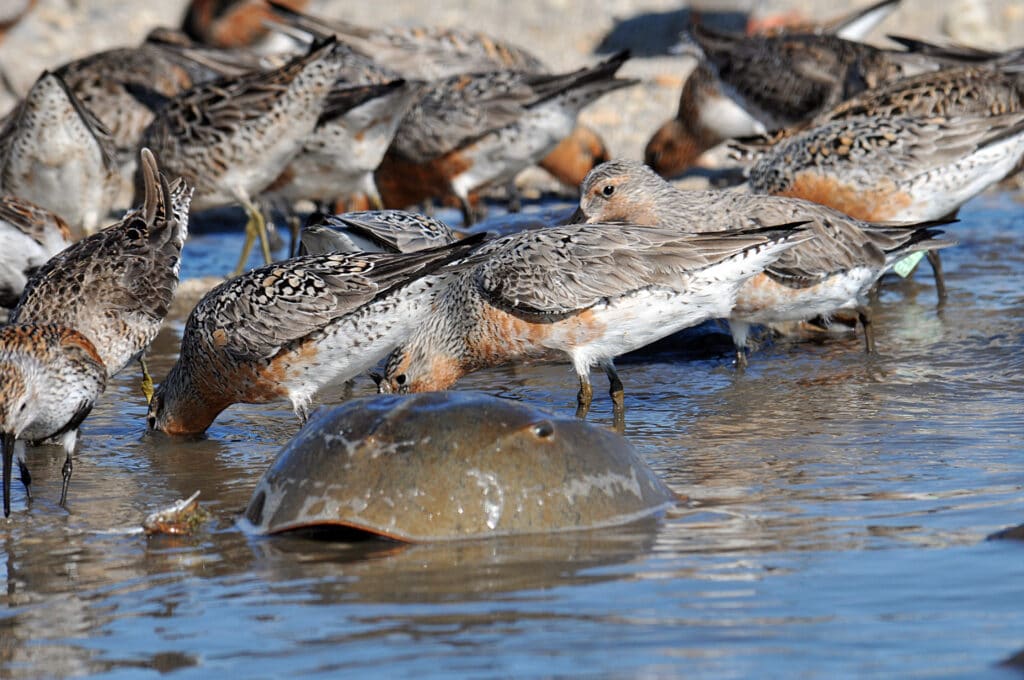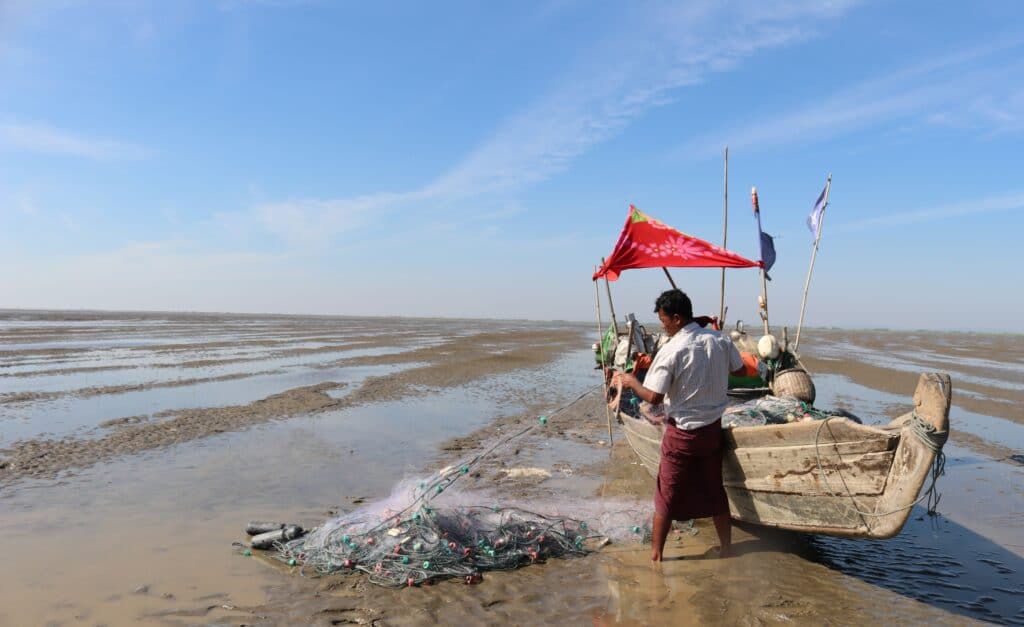Nowhere to go
The tragic case of Great Knot exemplifies what happens when things go wrong. In the 2000s, the Republic of Korea reclaimed 400 km2 of Yellow Sea mudflats at Saemangeum by building the world’s longest seawall. Ninety thousand exhausted migrants arrived where the estuary should have been – but found neither habitat nor food. Unable to refuel, they died in transit. Removing this food-rich stopover for migrating Great Knot reduced the species’ global population by 20–30%. In 2010, Great Knot was catapulted from Least Concern to Vulnerable, then uplisted to Endangered in 2015.
One eighth of the world population of the closely-related Red Knot (Near Threatened) uses the same flyway, so these birds run a similar gauntlet. But it is the subspecies rufa, journeying along the eastern seaboard of the Americas from the Arctic to Tierra del Fuego, that has most dramatically suffered unintended consequences of human enterprise. Its population has slumped by 75% in 15 years because of problems at a single site, Delaware Bay (USA). Unlike Saemangeum, its habitat remains intact – but there is no longer enough food. Red Knots have long timed their spring arrival to feast on Horseshoe Crab eggs. But the crabs have been so overharvested that the food source has expired. With insufficient energy to fly the final 3,000 km to Canadian breeding grounds, it was game over.
“Coastal wetlands,” van Gemerden emphasises, “are a lifeline for hundreds of species that migrate through them every year.” But as the two species of knot demonstrate, this lifeline is fraying. The tension between avian need and human greed renders coastal wetlands, according to van Gemerden, “one of the world’s most threatened habitats, devastated by pollution, disturbance, drainage and development projects – and disappearing or being degraded worldwide.” Things will worsen with climate change: modelling suggests that a 2°C rise would impact four out of five US sample sites, destroying 20–70% of their intertidal habitat.
Vanishing habitat
Globally, one sixth of mudflats (more than 20,000 km2 ) disappeared from 1984 to 2016. In the Yellow Sea, up to 65% of intertidal habitats has been lost in 50 years, vast muddy expanses reclaimed for agriculture, aquaculture or infrastructure. The difficulties many migratory birds face in completing annual migrations, van Gemerden says, are “leading to population collapses, pushing a suite of species towards extinction”. Moreover, this tragedy affects not just birds, but people too, given the importance of coastal wetlands in sequestering carbon and reducing flood risk through buffering wave energy.
Accordingly, coastal wetlands need urgent, intensive attention. “BirdLife is working with local communities across the world to protect and restore unique habitats,” van Gemerden explains. “The voices of local users help show how valuable healthy coastal wetlands are.”
Examples from the BirdLife Partnership are wide-ranging. The Bird Conservation Society of Thailand (BirdLife Partner), with support from BirdLife Species Champion Zeiss, is working with local conservation groups to protect working wetlands important for shorebirds such as Spotted Greenshank (Endangered). Audubon (BirdLife in the USA) has restored tidal marshland at San Pablo Bay, California, helping migratory shorebirds such as Willet as well as Black Rail (Endangered). BirdLife Cyprus has removed invasive reeds and created new pools to restore Akrotiri Marsh, a key breeding site for the migratory Ferruginous Duck (Near Threatened). Having worked on 70-plus coastal habitat creation projects in the UK, RSPB (BirdLife Partner) has consolidated its experience into a ‘sustainable shores’ action plan now being brought to a wider audience.
Tropical mangrove forests often shelter open coastal wetland habitats and guard communities against rising sea levels, so receive ample BirdLife attention. In Nigeria, BirdLife is funding a local women’s charity to promote mangrove agroforestry, thereby sustaining livelihoods and stabilising the coast. In Mexico, Pronatura (BirdLife Partner) has worked with villagers for 15 years to restore mangroves. Similar BirdLife initiatives have protected mangroves, and thereby helped both birds and people, in the Caribbean, Panama, Palau and Samoa.




